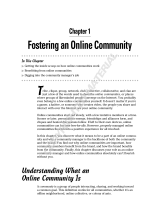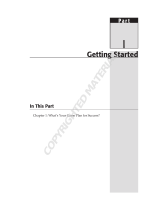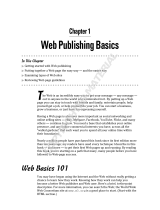Page is loading ...

“You blur the lines between a desktop experience and a
Web experience, and that’s really where everything is
headed.”
—Max Mancini
I
f you ask anyone about online auctions, chances are the first place they
would name is eBay. Ironically, eBay is more than just an auction. In fact,
eBay’s business is transactions. It just happens that their most known transac-
tions are those of people selling items to buyers on an auction site that carries
their name.
www.ebay.com
1
Max Mancini:
eBay
41998c01.qxd:Blogging Heroes 2/24/08 7:26 PM Page 1
COPYRIGHTED MATERIAL

eBay’s business is centered on charging a fee for bringing a seller and a
buyer together. This transaction fee is how eBay makes money regardless of
whether a marble, a car, or a piece of land in Texas is sold. It really doesn’t
matter what is sold as long as a transaction occurs.
eBay also provides a number of other services for doing commerce, includ-
ing PayPal, which, like eBay, makes money when transactions happen, but
instead of buyers and sellers exchanging products, PayPal makes it easy for
two people (or other entities) to exchange money. Using this simple transac-
tion model, eBay and PayPal both became leaders in the spaces they target.
If You Can Create a Compelling Experience for the
Consumers…
Max Mancini is the senior directory of disruptive innovation at eBay. Prior to
this role, he led over 70 developers at eBay, focusing on eBay Stores, registra-
tion, sign-in, merchandising, and more. He has also worked with eBay’s clas-
sified business, Kijiji (
www.kijiji.com).
Can you tell a bit about who you are and who you work for?
I’m Max Mancini, I work for eBay, and I run eBay’s Platform and Disruptive
Innovation team.
“Platform and Disruptive Innovation team” is an interesting title.
Can you expand on that?
Sure. There are two parts of my team.
On the platform side, our job is to
enable innovation. We want to ensure
that eBay is an E-Commerce operating
system, or platform, that can be
accessed by third-party developers to
create applications and other innova-
tions that accelerate commerce around eBay. Anywhere.
To give some context, our developers program, which is the responsibility
of my platform team, is seven years old. As part of the program, and central
to our platform strategy, we offer a series of web services that let any third
party create applications that tie into eBay’s “ecosystem.”
Our ecosystem is composed of developers as well as applications and cus-
tomer needs. Critically, our ecosystem has a clear value proposition for
“[Our] role is
to inspire
innovation through
experimentation.”
Web 2.0 Heroes
2
41998c01.qxd:Blogging Heroes 2/24/08 7:26 PM Page 2

third-party developers. And today, more than 25 percent of the listings on
eBay come through third-party tools.
Disruptive Innovation’s role is to inspire innovation through experimenta-
tion. We study trends and provide infrastructure and resources that
encourage developers, internally—and also externally—to think and create
within the boundaries of their known silos. The trends we concentrate on
shift over time.
Presently, the two big trends we see
are, first, that buyer expectations
have grown in terms of what they
demand from online commerce.
Today, people expect rich, interac-
tive experiences: things like Flash
and AJAX and JavaScript enabled
across the Web. The second trend
we are closely monitoring is social commerce, which relates to the comfort
people have sharing contact information and defining their relationships
online, across their social graph in every place it exists, i.e., Plaxo,
LinkedIn, Facebook, or MySpace. How much we share directly impacts the
overall trust models that exist. That’s something on which eBay has been
building, so we think it’s important to experiment with social environment
participation and learn how that affects what other people are doing in
commerce and how that affects the business. Across eBay, PayPal, and
Skype, eBay accounts comprise a lot of our social graph with a high empha-
sis on the trusted relationships where commerce flourishes.
Are you finding that people are willing to share more
information now?
Absolutely. That’s the trend we’re seeing. We’ve launched a Facebook appli-
cation as well as neighborhoods within eBay. Obviously there’s a different
twist to what you expect to do when you’re on eBay versus when you’re on
Facebook.
On Facebook, you’re in a social environment, and what interests you is dis-
covery with an entertainment factor—what are your friends doing? What
are their friends doing that I might have some interest in? It’s not as action-
oriented as you would expect on a site like eBay, of course. In eBay’s case,
you’re there to have some amount of entertainment but also to look for and
discover new things.
“You can’t necessarily
rely on individual
sites being where the
Internet economy
is going.”
Max Mancini: eBay
3
41998c01.qxd:Blogging Heroes 2/24/08 7:26 PM Page 3

This leads into the primary question: How would you and eBay
define Web 2.0?
I consider the first mashup—the Craigslist/Google Maps mashup—as an
embodiment of my view of Web 2.0. Somebody once described it as the
“atomization of the Web.” It’s taking all of the components and making them
available so that people can combine them in ways that you would never
have considered, or that are very personal for an individual experience.
So, the components that I see really defining Web 2.0 are platform or web
services, innovation that’s built on top of that platform or web services, and
distribution of that information. You see some of the embodiments of that
sort of thing today—for example the proliferation of widgets across
MySpace, Facebook, Google, and Yahoo!. Now you can combine informa-
tion from multiple sources easily and distribute that information around.
Distribution means that you can’t necessarily rely on individual sites being
where the Internet economy is going. Rather, you must ask what com-
pelling value are you delivering, and how do you monetize that value?
Getting back to eBay, it’s easy for us because the service that we provide is
all centered on transaction engines, and payments, through PayPal. As a
result, there are inherent monetization models both for eBay as well as for
developers and people who are using things that are distributed.
Another defining moment for the
trend in Web 2.0 was the development
of ad-supported models that made it
possible to monetize things that would
have otherwise been unmonetizable.
So integrating ads to contextually rele-
vant information—whether it’s some-
body’s blog, or somebody’s personal
home page, whatever it happens to be—meant you could make money off
of these things in ways that never existed before or couldn’t scale before.
Of all the things you mentioned, are any more important
than others?
Right now there’s an explosion of web services that have opened things up.
That’s an important enabler. However, that’s not going to be the definition
of success in the long run; it’s going to be expected out of everyone.
“What needs to evolve
is the monetization
models…Otherwise a
lot of companies will
go out of business.”
Web 2.0 Heroes
4
41998c01.qxd:Blogging Heroes 2/24/08 7:26 PM Page 4

What needs to evolve is the monetization models. The commerce-based
transaction model and the pure ad model as they exist today need to evolve
significantly. I don’t know what that’s going to look like, but it will have to
evolve; otherwise a lot of companies will go out of business.
Having some companies going out of business seems to be a part
of how things do evolve.
That’s true. I like to look back to 2000/2001, because the deal flow and VCs
[venture capitalists] and everything else sure look similar to today—in
fact, you’re starting to see some similar companies pop back up on the
radar screen. The difference is that these companies have a way to last
longer and bootstrap more because of advertising models, frankly, and affil-
iate programs. They have a longer rope, if you will, but that still doesn’t
create the real economic value that needs to be put in place in some of
these businesses.
You mentioned “2000/2001,” and the bubble that “burst.” Do you
see a bubble now as well and is there a risk it will burst?
There’s a bubble now. I don’t know if it has the same risk of bursting
because the previous bubble was created entirely as a result of the IPO mar-
ket and that mechanism. The current bubble seems more tied to the M&A
market, but it’s not as aggressive as what the IPO market was. And, there’s
a bit more revenue backing to some of these startups.
So, there is a different kind of bub-
ble although I don’t know how early
we are in it; it’s certainly very
aggressive right now. I don’t think it
has the same risk of bursting as
quickly as the previous one did.
You mention monetization and the sharing of information. This
leads to the question of security. Do you see security continuing
to be an issue?
Security hasn’t been addressed yet in a lot of these models. I’m in a unique
position of being able to sit back and see some of these things. We saw the
value in creating this kind of model due to the selling side of our business,
and we’re expanding on the buying side much more aggressively now.
“The bigger the
target, the more
attention you get from
the bad guys.”
Max Mancini: eBay
5
41998c01.qxd:Blogging Heroes 2/24/08 7:26 PM Page 5

So, getting back to the definition of Web 2.0, it’s creating a lot more open-
ness so you can integrate things that you would have had to build from
scratch before; how you manage rights and security within that model has
yet to be determined.
In the early days, even Facebook was hammered on how much they shared
information. They probably have the biggest head start in terms of creating
a model where you can define trust a little bit more specifically.
I’m not sure that’s addressing all of the
security issues. Social networking isn’t
really addressing any of it right now,
but people are going to address this;
security always shows up. It’s a func-
tion of how much monetization occurs
in the model and how early, and we’re
not quite at the big levels of monetiza-
tion yet where security becomes as big
of a concern as it should.
eBay has done security and what we internally call “trust and safety” pretty
significantly. Obviously being a huge marketplace means that people will
try to figure out how to take advantage of others. The security model gets
built in and the bigger the target, the more attention you get from the bad
guys. With the exception of something like click fraud in CPC kinds of
models, none of the Web 2.0 stuff is at that scale yet.
All of that will happen, but you address it when it happens. Much of that
will evolve with Web 2.whatever.
On Web 2.0, everyone has his or her own definition. Is there
anything about Web 2.0 you believe people are misunderstanding?
That’s a good question. Everybody seems to have a derivative or a variant
on the same theme—at least among the people I talk to.
Let me ask a different question then. AJAX, Adobe’s AIR,
Microsoft’s Silverlight—a lot of these technologies coming out—
how do these fit into a Web 2.0 world?
People have defined Web 2.0 as AJAX, so that’s missing the boat. AJAX is
a component; it’s an enabler to things that are evolving with Web 2.0, and
it’s a contributing technology, but in and of itself it doesn’t define Web 2.0.
“As messed up as our
cell phone service is
in the United States,
I can’t imagine us in
a situation where
we always have
connectivity.”
Web 2.0 Heroes
6
41998c01.qxd:Blogging Heroes 2/24/08 7:26 PM Page 6

I can speak more specifically about Adobe AIR because we’ve built a product
on that. There’s a lot of momentum around creating interactive experiences
leveraging Web 2.0 technologies and web services, so what Adobe is saying
is, “Why can’t we do even better by taking those same technologies and
bringing them to the desktop and allowing you to leverage the web services
in the same way and as simply as you were able to through the Web?”
Adobe is jumping on something that could be quite significant in terms of
how we experience the web, which is, the web really isn’t about a web
browser—we experience it that way today, but it doesn’t have to be.
If you think about it (and I don’t
think this example is the best),
Yahoo!’s desktop widgets don’t take
advantage of the same dynamic that
normal web widgets do, which is
viral distribution. That’s another
important dimension of what’s hap-
pening on the Web.
So, the concept of Adobe AIR, and
in theory, Silverlight (although I’m
not familiar with it) is smart, in that you blur the lines between a desktop
experience and a web experience, and that’s where everything is headed.
A colleague on my team likes to say that Web 3.0 really happens when peo-
ple stop talking about the Web, the desktop, and Web 2.0—it’s just the way
we interact with our computer. It’s transparent whether it’s local or on the
Net. AIR is just a first step in that direction.
That brings up the issue of online versus offline and the topic of
connectivity. Do you foresee a day when connectivity availability
is not an issue?
I’ve thought a lot about that since we’ve invested in our eBay desktop
product on the AIR platform. One of the benefits is that you can do offline
activities.
As messed up as our cell phone service is in the United States, I can’t imag-
ine us in a situation where we always have connectivity—I’d love for us to
get there. I don’t know when it’s going to happen; if you’re willing to pay
“I believe in enabling
your business to
operate no matter
what the next big
thing is, and letting
other people
catch up.”
Max Mancini: eBay
7
41998c01.qxd:Blogging Heroes 2/24/08 7:26 PM Page 7

enough, you can get it, right? I just don’t see the average person being con-
nected continuously, with the exception of through their mobile device.
In developing countries, mobile is the way most people connect to the
Internet. Although there’s a lot of innovation and excitement around
Web 2.0, certainly in Silicon Valley, the mobile investments are starting to
pick up again. The first wave of investments may have been too early; I don’t
know what it was. I don’t know if this next wave is going to stick, but if I
were looking at where the real opportunity to reach the majority of the
world is, it’s not going to be in the PC in the home.
That leads into the question, what do you see as the next
big thing coming?
That’s a good question.
There’s plenty of opportunity in mobile; people are just going to have to be
there, to engage with people when they’re connected. It’s hard to tell.
I believe in enabling your business to operate no matter what the next
big thing is, and letting other people catch up.
Let me describe what I’m talking about.
I would rather spend money building our platform structure and web
services, so that when the next big thing happens, our platform is that
next big environment. For eBay, obviously we have our three major busi-
nesses, PayPal, Skype, and eBay marketplaces, and those are independ-
ently very huge markets for us. I’m not specifically looking beyond our
marketplaces’ business and how buyer experience and social commerce
might affect those.
Shifting back to an earlier comment, you mentioned Web 3.0.
Some define Web 3.0 as the Semantic Web. Do you have any
opinions or thoughts on the Semantic Web?
Well, I don’t think it’s the Semantic Web.
The next generation of search and find for discovery across the Web
will be much more like what my interpretation of Semantic Web is, which
isn’t necessarily what everyone else shares. It’s a trend I did mention on
Web 2.0; one reason Web 2.0 happened was that it became so easy and
Web 2.0 Heroes
8
41998c01.qxd:Blogging Heroes 2/24/08 7:26 PM Page 8

cheap to publish, right? As an individual I can create a hugely popular blog
with almost no marketing experience or background team. Self-publishing
has enabled many things to happen; frankly, it’s supporting a lot of the
economy, from a page-view perspective, in that you can distribute widgets
in content, things like that.
So I think that the same thing will happen with the Semantic Web, or next-
generation finding experience on the Web which is, “How are people iden-
tifying content in a way that can be aggregated and useful to browse
through, or search through, or discover.” The concept of meta tags and tag-
ging clearly had some early momentum and we acquired a company,
StumbleUpon [see Chapter 15 for more on StumbleUpon] which takes into
consideration this concept of not only identifying the social bookmark
aspect of it, but tagging things.
I over-simplify the concept of
Semantic Web because I don’t fore-
see people assigning detailed attrib-
ute definitions to everything that’s
in their content out there. I think
there’s a huge opportunity. I used to
run a company called Consumer
Review, and our objective was to get
product reviews from passionate
enthusiasts on particular product categories. Consumer- or community-
generated content is huge. It creates huge value, and it’s even easier to do
now. The Semantic Web can evolve out of stuff like that over time.
I just don’t know how the value chain works. Where’s the incentive structure?
Another company that eBay has acquired, Epinions, was a consumer-gen-
erated review site. They set up a virtual economy for motivating people to
do things, but ultimately, the majority of the contributors are a small per-
centage of the population.
So, in order for the Semantic Web to really come about, there needs to be
a shift in people’s ability and willingness to help tag and categorize infor-
mation across the Web. Some of the bigger companies are going to have to
participate a bit more in standardizing around this.
“‘Stop worrying about
having to manage
your infrastructure;
start worrying about
your products and
your innovation.’”
Max Mancini: eBay
9
41998c01.qxd:Blogging Heroes 2/24/08 7:26 PM Page 9

Do you believe that shift will come? Do you think people will be
willing to tag information?
I actually do, but I don’t know what the trigger is going to be. Let me tell
you why I think that: I hate to use Facebook as an example, but they
changed a lot of things with some basic activities.
By opening up their platform, they got every major Internet company to
ask, “How do we open up our platform more?” Google responded with
OpenSocial, which while it’s a marginally off-of-a-paper-napkin kind of
launch, might just take off! They started off with the right things, and they
know they need to get into the game more aggressively off their platform
than they have in the past and get other people to do the same thing.
OpenSocial encourages other companies, who have typically held their
information very tightly, like a LinkedIn [discussed in Chapter 9] and a
Plaxo, to open their platforms more.
SalesForce has understood this concept for a long time. We’ve understood
it. Yahoo has understood it to a certain extent. And, Amazon actually
jumped on this bandwagon a few years back and has made great progress.
Let’s jump to another term that is being used today—Software as
a Service (SaaS), or Software plus Services (S+S). What is your
thought on these?
Great ideas. Once again, the real test for adoption on those won’t be small
companies; it’ll be the big companies. The small companies will adopt it,
because economically it makes a lot of sense.
The general philosophy is, “Stop wor-
rying about having to manage your
infrastructure; start worrying about
your products and your innovation.”
And that’s a great message. So, if you
can focus your business and your
employees to do things that truly mat-
ter to the bottom line and not worry
about infrastructure to support your software and manage it as a service, it
makes a lot of sense.
Big companies are going to be reluctant, because they don’t want to have
core-business infrastructure in a place that they don’t control. Big companies
“Big companies love
control; they need
predictability. Wall
Street does not like
unpredictability.”
Web 2.0 Heroes
10
41998c01.qxd:Blogging Heroes 2/24/08 7:26 PM Page 10

love control; they need predictability. Wall Street does not like unpredictabil-
ity, and if you release that control too much, you run the risk of catastrophe.
That’s why it will take a long time to get there.
Shifting back to Web 2.0, what has eBay done in the Web 2.0
space that you would consider really cool?
First, we built a widget in May of this year called eBayToGo. You can take a
look at it at
http://togo.ebay.com. As simple as widgets are, the reason that
this one is meaningful is that it creates a compelling interactive eBay
Anywhere experience delivering unique and customized content from our
site and publishing it on a third-party site or blog. From our perspective, it
also helps show that distributing eBay off of eBay.com is very important to
our business.
The other cool thing is desktop.ebay.com, which my team is developing.
This application is written on Adobe’s AIR platform, which creates an expe-
rience that you just can’t get on the Web today in this environment on your
desktop.
For us, once again, it’s distribution. I
look at delivering the eBay experi-
ence off of eBay.com in four places.
The first is delivering it across the
Web through distribution of widgets
and core functionality. I’m talking
buying experience now, not selling,
so this is enabling widgets, not just
promoting items that are on eBay for sale, but also allowing people to pur-
chase directly from the widget. That’s something that we’re working on
internally, and we talk about. Hopefully in Q1 of next year we’ll start to see
this stuff proliferate across the Web. That’s cool because you can put some-
thing up on your blog and not have people leave the blog but stay in that
experience and have very relevant, very tailored kinds of products, depend-
ing on what you’re talking about. So, that’s distribution across the Web.
The second place is distribution on the desktop. There are a lot of desktop
PCs that are shipped, and it’s always great to have a desktop link on ship-
ping PCs. While having a Web link is okay, if you can create a compelling
experience for the consumers, then that’s really important. Our eBay desk-
top product is one of those examples.
“If you can create a
compelling experience
for the consumers,
then that’s really
important.”
Max Mancini: eBay
11
41998c01.qxd:Blogging Heroes 2/24/08 7:26 PM Page 11

The third is distribution into the digital living room, which is one of those
fits and starts. It’s tried, but hasn’t gone anywhere. Third parties have cre-
ated things for eBay through our platform, like this company called
BuyOff, in Austin, Texas, when they launched with Time/Warner cable in
Austin. They’re also launching across a lot of Time/Warner areas with eBay
in the cable set-top box. Pretty interesting. We’ve got a third party who
developed a Windows Media Center application. We’re really looking at
that, but it’s more of an early “Hey, let’s see what’s going on.” But it’s pretty
important to learn and know how these things develop.
And then the last one, of course, is mobile, from a distribution perspective.
From my point of view, in five years,
eBay is going to be much more about
eBay across the Web than it’s going to
be about eBay.com. Every big company
needs to think that way. Although the
trend is there, big companies, I don’t
think, are necessarily…it’s a tough
one. It’s a lot easier to control and pre-
dict behavior when it all happens on your web site.
Do you see Web 2.0 features justifying their cost? Do some of the
things you’ve done at eBay justify the cost of development?
It depends on how you compare cost. I would say that one of the other
beauties of the Web 2.0 evolution is that it’s a lot cheaper to develop things
like this, because it’s easy to write or integrate with a REST API or to lever-
age a web service. Now you’re seeing some tool companies come out with
creative tools that automatically read in the WSDLs that define different
web services that are out there and allow you to drag and drop to create
things; things like Yahoo! Pipes.
All of these tools are designed to make it easy to leverage web services to
create widgets and distribute applications. The cost of development is
going down for those things, but the early days of development are pricey,
although not as pricey as writing a desktop app—I can tell you that! It’s all
relative. For me, it’s cheap compared to core development/core infrastruc-
ture costs.
That’s another reason that there are so many companies out there right
now—because they can actually launch their company without having to
“One of the other
beauties of the
Web 2.0 evolution is
that it’s a lot cheaper
to develop things.”
Web 2.0 Heroes
12
41998c01.qxd:Blogging Heroes 2/24/08 7:26 PM Page 12

invest a lot of development dollars. The differentiation is not going to be
investment dollars on the technology side; the technology is getting easier
and easier to use. It’s going to be entirely based on user experience and
what information are you combining in the right way.
Is there anything about Web 2.0 or eBay that you’d like to add?
Just that the sheer volume of content and interesting stuff—which is pro-
liferating at an accelerated pace, coupled with the ability to find it, has
enabled this economy, if you will, the ability to create widgets and distrib-
ute them.
Without the early days of personal home pages evolving into blogs, evolv-
ing into creating mashups easily, or whatever—self-publishing in any
way—obviously video through YouTube—all those things are really foun-
dational elements. It is important to note that.
Sound Bites
eBay is one of the best-known successful web sites. When you add PayPal and
Skype to the mix, you have a company with great web experience. Max
Mancini, who runs the Platform and Disruptive Innovation team for eBay, is
in a great position to provide insights on Web 2.0 and more. Some of his per-
spectives follow:
•
Internet users expect rich, interactive experiences. On sites, differen-
tiation will be based entirely on user experience and how information
is combined. A defining moment for Web 2.0 is people opening their
platforms to allow others to use the information in ways that the
platform provider never thought of. Web 2.0 is really defined as
enabling people to create new things.
•
“Atomization of the Web” is taking all of the components and mak-
ing them available for combination in unconsidered ways, or in ways
that are very individual.
•
You can’t necessarily rely on individual sites as being where the
Internet economy is going. Rather, you should determine what com-
pelling value you are delivering and how you can monetize that
value.
•
Another defining moment for the trend in Web 2.0 is being able to
monetize things that would have otherwise been unmonetizable. The
Max Mancini: eBay
13
41998c01.qxd:Blogging Heroes 2/24/08 7:26 PM Page 13

monetization models really have to evolve. The commerce-based
transaction model and the pure ad model as they exist today need to
evolve significantly.
•
Web 2.0 is creating more openness in integrating things that you
would have had to build from scratch before. Nobody has even
started looking at how you manage rights and security within that.
We’re not quite at the big levels of monetization yet where security is
as big of a concern as it should be.
•
Blurring the lines between a desktop experience and a web experi-
ence is where everything is headed. There is a lot of momentum for
creating interactive experiences leveraging Web 2.0 technologies and
web services. We’re taking these technologies, bringing them to the
desktop, and allowing people to leverage the web services in the same
way and as simply as they could through the Web. After all, the Web
really isn’t about a web browser—we experience it that way today,
but it doesn’t have to be.
•
Big companies love control; they need predictability. Wall Street does
not like unpredictability, and if you release that control too much,
you run the risk of catastrophe. Enable your business to operate no
matter what the next big thing is, and let other people catch up.
Web 2.0 Heroes
14
41998c01.qxd:Blogging Heroes 2/24/08 7:26 PM Page 14
/










